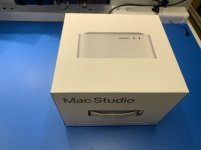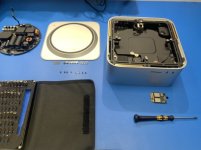Hello
A basic MacStudio M1 Max (2022) upgrade from 512GB to 4TB was just tested yesterday.
And it works out well:






I measured both configurations' write speeds in my tests:

The initial speed of a single 512 GB NAND card is 4.09 GB/s.

The single 512GB NAND stalls at 690MB/s after the SLC cache is full.

6.91GB/s is the starting speed for the pair of 2TB NAND cards.

After filling the SLC cache, write speed drops to 3.14 GB/s. It should be noted that the AppleConfigurator restore fails with an error if the 2TB NANDs are inserted incorrectly.

Important information substitution or improvement There are currently no NAND cards for the Mac Studio available anywhere.
Apple has no plans to sell them. One could extrapolate the events of the iMac Pro (2017) and the Mac Pro (2019) and envision that NAND modules resembling those of the Mac Studio would be made available on the market if Apple ever ships a new Apple Silicon Mac Pro. Though wildly speculative, this is feasible.
However, the Mac Studio's NAND daughtercards are configured in precisely the same way as the M1 MacBook Pro 14" and 16". Additionally, they make use of the same BGA110 Nands chips, which are sold on the black market, that are used in the iPhone 11 to 13 and all of the M1 and M2 Mac models.
On a T2 Intel Mac or an M1 or M2 Mac, NANDs can already be upgraded by soldering BGA chips.
Therefore, a PCB could be constructed, soldered with BGA NANDs (for example, four Kioxia KICM229 would create a 2TB NAND daugter card), and then programmed using a JCID programmer.
However, those NANDs are highly exclusive to Apple (they are not standard NANDs; the IC integrates NAND with a custom ARM core connected via a PCIe link to specific lines in the M1 CPU), so no third party company (like OWC) may ever sell this.
Additionally, producers like Kioxia and Hynix are prohibited from selling their BGA 110 Nand production to outside businesses due to exclusive contracts with Apple.



A basic MacStudio M1 Max (2022) upgrade from 512GB to 4TB was just tested yesterday.
And it works out well:
- Remove the 512 GB NAND
- Place the two 2TB NANDs inside the slots in the correct order.
- Use a different Mac and Apple Configurator to restore the MacStudio bridgeOS
- and voila!






I measured both configurations' write speeds in my tests:

The initial speed of a single 512 GB NAND card is 4.09 GB/s.

The single 512GB NAND stalls at 690MB/s after the SLC cache is full.

6.91GB/s is the starting speed for the pair of 2TB NAND cards.

After filling the SLC cache, write speed drops to 3.14 GB/s. It should be noted that the AppleConfigurator restore fails with an error if the 2TB NANDs are inserted incorrectly.

Important information substitution or improvement There are currently no NAND cards for the Mac Studio available anywhere.
Apple has no plans to sell them. One could extrapolate the events of the iMac Pro (2017) and the Mac Pro (2019) and envision that NAND modules resembling those of the Mac Studio would be made available on the market if Apple ever ships a new Apple Silicon Mac Pro. Though wildly speculative, this is feasible.
However, the Mac Studio's NAND daughtercards are configured in precisely the same way as the M1 MacBook Pro 14" and 16". Additionally, they make use of the same BGA110 Nands chips, which are sold on the black market, that are used in the iPhone 11 to 13 and all of the M1 and M2 Mac models.
On a T2 Intel Mac or an M1 or M2 Mac, NANDs can already be upgraded by soldering BGA chips.
Therefore, a PCB could be constructed, soldered with BGA NANDs (for example, four Kioxia KICM229 would create a 2TB NAND daugter card), and then programmed using a JCID programmer.
However, those NANDs are highly exclusive to Apple (they are not standard NANDs; the IC integrates NAND with a custom ARM core connected via a PCIe link to specific lines in the M1 CPU), so no third party company (like OWC) may ever sell this.
Additionally, producers like Kioxia and Hynix are prohibited from selling their BGA 110 Nand production to outside businesses due to exclusive contracts with Apple.






